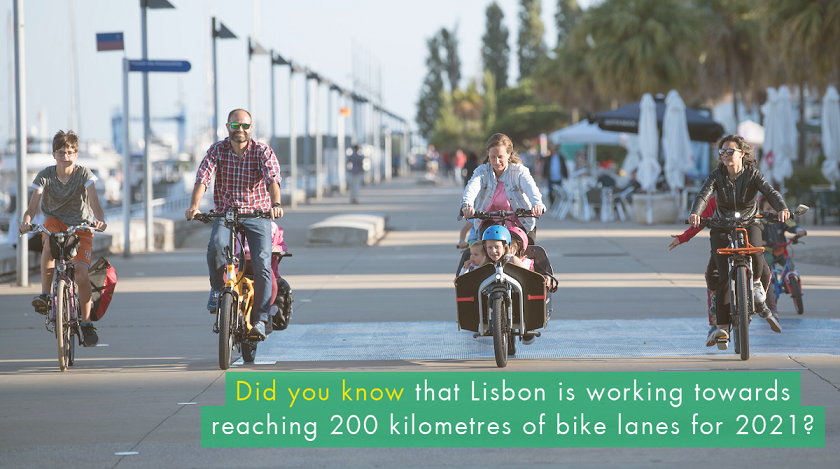
MOVE Lisboa: what is on the horizon for cycling in Lisbon?
Filled with colourful narrow streets and built on a unique topography, Lisbon is undoubtedly a challenging city when it comes to mobility. Over the past decade, Lisbon has started to undergo a mobility paradigm shift, which translates into major transformations in the way citizens move around the city.
The City Council of Lisbon recently released its new strategic mobility vision for 2030, MOVE Lisboa, reaffirming its commitment to renew Lisbon’s transport options. If the bicycle is in the spotlight, can we predict a bright future for cycling in the so-called ‘City of the 7 hills’?
Contrary to popular belief, 73% of Lisbon’s streets are flat or have slopes of less than 5%, making them accessible to most cyclists. However, only in 2017 has the bike started to be considered a real mobility alternative for many people in Lisbon. The increase of the cycling infrastructure in the urban network, together with the introduction of the public bike-share system GIRA, helped change people’s attitudes towards cycling. Despite this important shift, still only about 0.6% of the trips in Lisbon were made by bicycle in 2017. Although this number shows a growth of around 200% compared to 2011, the substantial increase was still far away from the 40% modal share registered in some European cities.

Lisbon’s cycling infrastructure has been developing constantly since 2009, with a strong focus on the city core since 2015, when cycle paths started to be built on the city’s central artery and uptown avenues. Until 2021, the city is working towards reaching 200 kilometres of bike lanes, assuring that 93% of the population has access to a cycling lane within 300 meters from their home, as well as offering a total of 27 cycle-pedestrian bridges. Not bad for a city that inaugurated its first 3km of cycleway back in 2001, right?
The municipality also promotes intermodality in its urban network, where bikes can travel for free on Lisbon’s subway, bike-bus routes, urban, regional and inter-city trains, as well as in all ferry boats crossing the Tagus River to and from Lisbon.
What changes can ‘Lisboetas’ expect to see on the cycling horizon?
Lisbon already has a nice story to tell, but with Move Lisboa, the City Council renews its urban mobility strategy and shares its vision about what mobility should look like a decade from now:
Creating a people-centred mobility ecosystem that is accessible, useful, reliable, and safe, built on an integrated public transport network, complemented by innovative solutions, which enable conscious and sustainable choices, positioning Lisbon as the European capital of reference in the area of mobility by 2030.
The proposed Mobility Plan is built around 5 networks and 5 services, shaping the multimodal and intermodal transport system:

Among the 5 networks showcased, cycling appears to be a fundamental pillar in the renewed mobility system. Indeed, Lisbon proposes to become a cycling city, and aims at making the bicycle an easy and attractive transport mode, increasing in turn, its share in the modal split.
Cycling key measures
- Consolidating a structured, continuous, safe, and functional cycling network, which connects interchanges, residential areas, large infrastructures, job areas, green and leisure zones, with at least 200 km of new cycle routes
- Promoting the safe use of the bicycle in residential areas, through traffic calming measures in the neighbourhoods, and the improvement of cycling connections between them
- Promoting complementarity between bicycles and public transport
- Providing and facilitating access to the bicycle by supporting their purchase
- Disseminating a network of racks for short-term bike parking, and creating safe long-term parking at interchanges and car parking lots
- Implementing a dense and comprehensive public bicycle sharing system covering the entire city, offering also shared electric bikes
- Promoting traffic calming measures and space sharing between low-speed vehicles, through a global network of Zone 30
- Providing information to the public, raising awareness about the advantages of using the bicycle, and promoting its use for daily commutes
- Reinforcing the creation and use of digital tools for cycling and other active modes
With the release of MOVE Lisboa, Lisbon joins other forward-thinking European cities in re-thinking their mobility systems, aspiring to shift from a car-centred city to a pedestrian, cyclist and public transport-based model. By placing cycling at the forefront of its renewed mobility strategy, the City Council aims to promote the bicycle as a vehicle for change, striving to transform the city and to offer a greater quality of life to its citizens.
Velo-city 2021 Lisboa will be the perfect opportunity to look back at what the city has achieved during the last decade and present its ambitious Vision for 2030. It will be a unique moment to celebrate Lisbon’s commitment towards sustainable urban development, to share experiences, and to inspire others on the path of more liveable cities.
Regions:
Network/Project Involved:
Contact the author
Recent news!
Upcoming events
Contact Us
Avenue des Arts, 7-8
Postal address: Rue de la Charité, 22
1210 Brussels, Belgium









